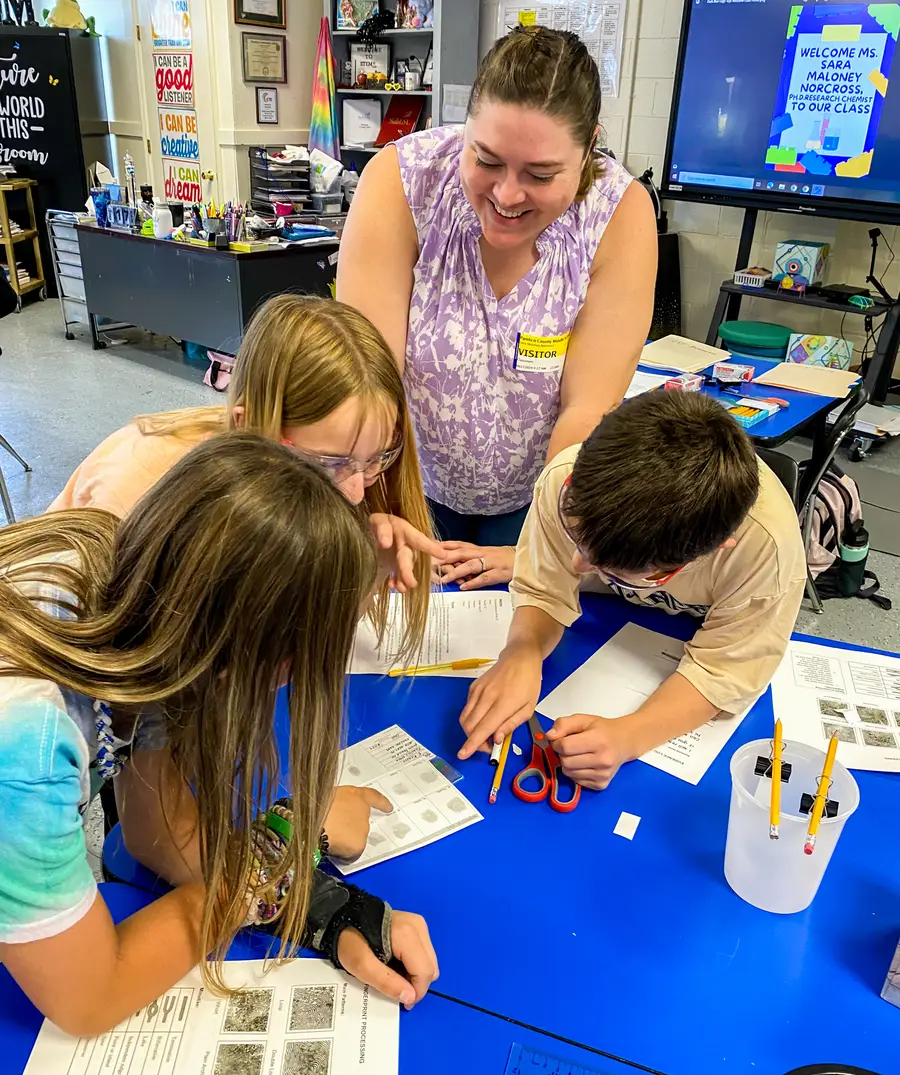In celebration of the North Carolina Science Festival, RTI researchers participated in SciMatch, visiting middle schools across the state to engage young students through hands-on activities.
Bringing science to local communities and students is essential for inspiring the next generation of researchers. "It shows kids that they can do anything they put their minds to and that scientists can look like them," said Kimberly Jenkins, a lab technician working in drug development who visted Fuquay Varina Middle School.
RTI scientists organized activities around forensics, microplastics, chemistry, and more. See below for some photos of the visits.

Students at Pamlico County Middle School solved a mystery involving a missing painting using forensic science techniques such as fingerprinting and paper chromatography.

Sara Maloney Norcross, a chemist at RTI, works with Pamlico County Middle School students to complete a forensics fingerprinting activty.

Leslimar Ríos-Colón, a chemist at RTI, visited Zebulon Gifted and Talented Magnet Middle School: Center for Advanced Studies and STEM to discuss sources of microplastics and how they affect human health.

Microplastics, such as those shown in this dish, are small pieces of plastic that can have major health and environmental effects. Students at Zebulon Gifted and Talented Magnet Middle School: Center for Advanced Studies and STEM learned about how microplastics can harm many of our bodies' internal systems.
"Science outreach can show kids what a life in science looks like and brings the fun side of science to the forefront," said James Harrington, a chemist at RTI who visited Southern Wake Academy in Holly Springs. "By talking to a professional scientist, kids can come to understand how their interests and passions can be found in science."
"RTI’s motto is to improve the human condition with science-based solutions, and these students are the next generation of scientists," said Sara Maloney Norcross. "It’s wonderful that RTI and NC SciFest supported our visit with these schools."
Supporting Future Scientists from Home
Inspiration isn't limited to the classroom—you can spark curiosity at home through hands-on activities that use household products. See below for step-by-step instructions for one of our NC SciMatch forensics activities.

Results of paper chromatography using markers and strips of paper. Paper chromatography is a chemical method used to separate chemicals of different colors and can be performed with basic household items.
Paper Chromatography to Analyze Marker Ink
Materials needed:
- Coffee filters (alternatively, paper towels)
- Small cup
- Water
- Washable markers
Process:
- Fill the small cup with water until it is approximately 1 inch deep.
- Draw a circle with a washable marker about 2 inches from the center of the coffee filter, or 2 inches from the bottom of the paper towel.
- Fold your coffee filter in half twice (it should look like a slice of pizza).
- Place the pointed end of the coffee filter or paper towel into the water cup. The marker line should be above the water.
- Allow the water to travel up the coffee filter or paper towel, separating the pigments.
- Remove the coffee filter or paper towel from the cup and observe what colors are present.
Discussion Questions:
- Test a few different types/brands of black, washable markers. Notice how different brands use different mixtures of pigments to achieve a black color.
- Make guesses before you use your coffee filter chromatography on the markers. What different colors do you think are used in the marker? For example, many green markers have both yellow and blue pigments!
- In our SciMatch activity, we used this to test which black marker was used to write a ransom note. Where else do you think this technique could be useful?
Learn more about RTI's particpation in the 2024 North Carolina Science Festival.
